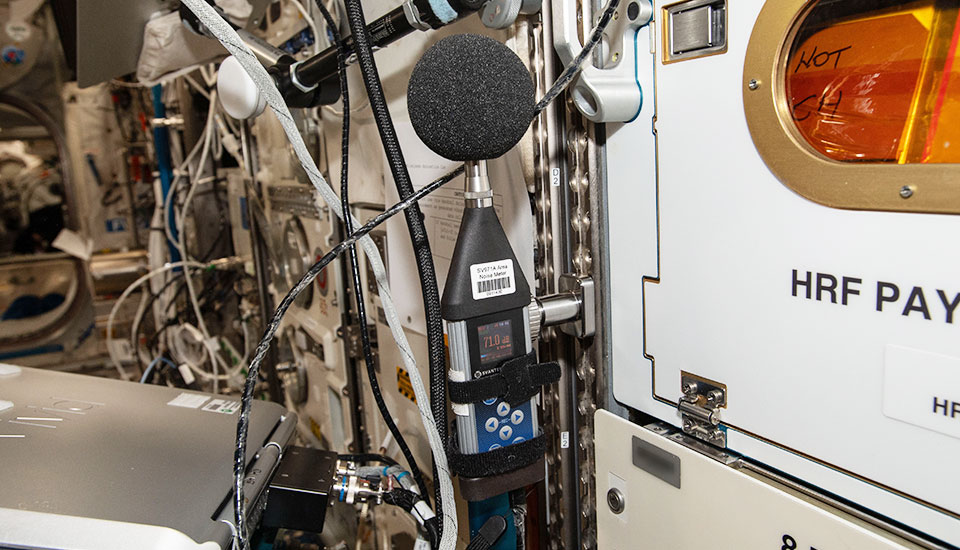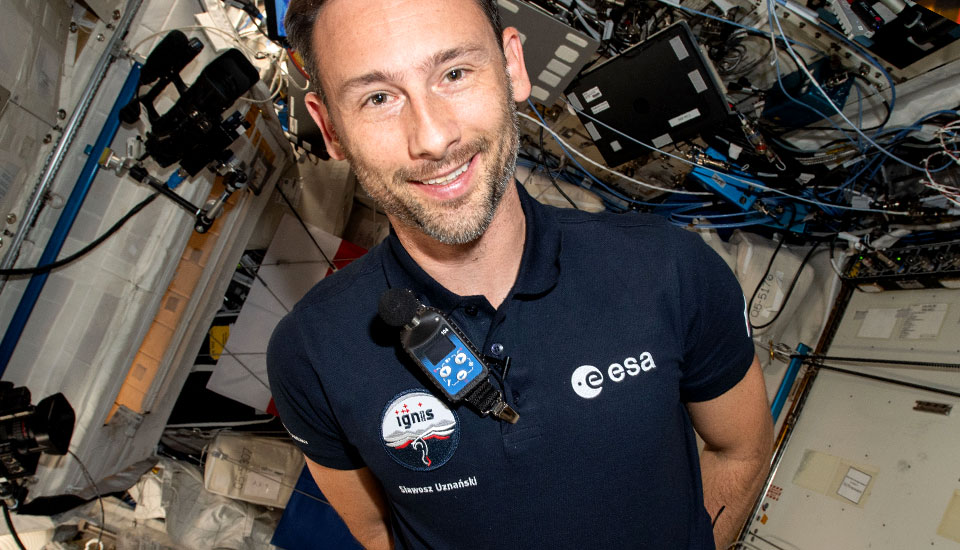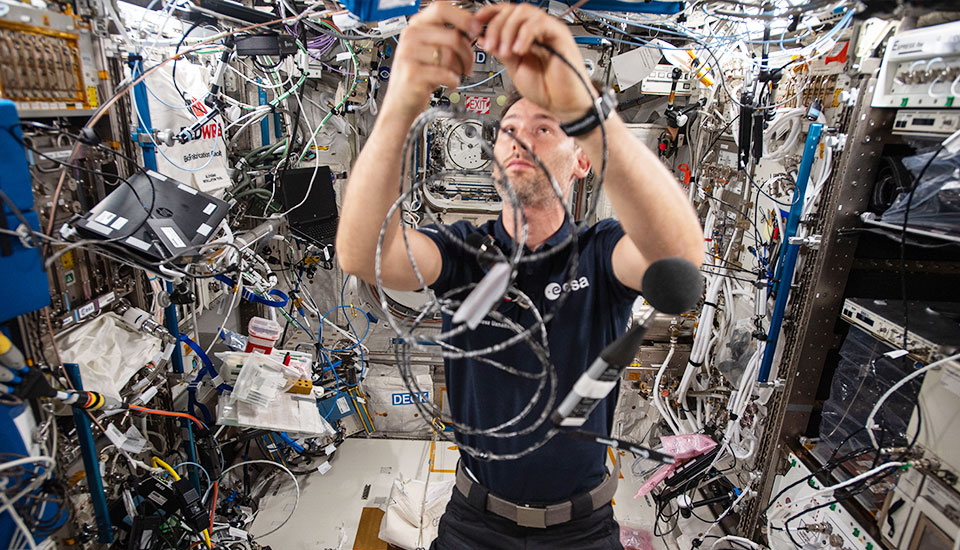
COPYRIGHT: ESA–S. Uznański-Wiśniewski
The project successfully tested new commercial-off-the-shelf hardware from Svantek, confirming its reliability, enhanced usability, and seamless data integration, paving the way for its use on future deep-space missions like the lunar Gateway.
The technology demonstration yielded five clear and significant outcomes that validate the next-generation system for future space missions.
The new Svantek hardware proved highly reliable and robust, showing no significant performance degradation from exposure to the ISS environment.
The SV 104A dosimeter provides a superior user experience, with astronauts finding it significantly more comfortable, less obtrusive, and easier to use than the legacy SV 102A+ system.
Wireless data transfer via Bluetooth was successfully demonstrated, simplifying the data management workflow and enabling integration with modern platforms like the EveryWear app.
The inclusion of a high-vibration sensor is a key advantage, allowing for the exclusion of unwanted data and improving the reliability of noise exposure calculations in microgravity.
The project validates the commercial hardware as a viable and superior alternative for future Crew Health and Performance acoustic monitoring systems on missions like Gateway.
In the confined habitats of space, robust acoustic monitoring is not a luxury but a strategic necessity for crew health and mission safety. High noise levels pose significant risks, interfering with crucial communications, masking safety alarms, and contributing to long-term health problems such as noise-induced hearing loss. Because crew members cannot simply walk away from a noise source, continuous and accurate monitoring is essential to mitigate these dangers.
Crew Health and Performance (CHP) systems are designed to manage these stressors across four functional areas: Medical Capability, Countermeasures, Behavioral Health, and Environmental Health. Within this framework, acoustic monitoring is a critical component of environmental health, ensuring that sound levels remain below established safety limits to safeguard both the immediate operational effectiveness and long-term well-being of the astronauts.
While Svantek’s SV 102A+ dual-channel noise dosimeter has been the operationally proven instrument on the ISS, the upcoming Gateway program demands a more advanced solution. The legacy system presents two key drawbacks: smaller and lighter alternatives now offer a less obtrusive option for personal dosimetry, and the SV102A+ relies on proprietary software that complicates integration with modern, open-architecture data systems like the CNES ‘EveryWear’ software – a cornerstone of the planned CHP system for Gateway.
This clear need for an updated system led directly to the development and in-orbit validation of a new, more integrated acoustic monitoring capability.
The Wireless Acoustics ISS Technology Demonstration was designed to showcase a new, integrated CHP acoustic monitoring system built around modern hardware. The project introduced two new Svantek devices: the compact SV 971A for fixed-area sound monitoring, and the small, unobtrusive SV 104A personal dosimeter worn by the crew. The core purpose of the demonstration was to validate the performance, usability, and data integration capabilities of this new hardware in the unique microgravity environment of the ISS, providing a direct comparison against the legacy system.

SV 971A
Class 1 sound level meter on a space station
COPYRIGHT: ESA–S. Uznański-Wiśniewski

SV 104A
Noise dosimeter in operation aboard a space station
COPYRIGHT: ESA–S. Uznański-Wiśniewski
Demonstrate Data Acquisition: The first goal was to validate the fundamental functionality of the hardware in space. This involved confirming that the body-worn SV 104A could accurately measure an astronaut's personal noise exposure and that the fixed SV971A could effectively monitor the ambient acoustic environment in the Columbus Module.
Verify Data Transfer: A key advantage of the new system is its wireless connectivity. This objective aimed to confirm the successful transfer of acoustic data via Bluetooth from both devices to the EveryWear software running on an ISS iPad, proving its compatibility with future data architectures.
Assess User Experience: Hardware is only effective if the crew can use it without it becoming a burden. This objective focused on documenting the astronauts' experience with the new body-worn SV 104A, comparing its comfort, unobtrusiveness, and ease of use directly against the legacy SV102A+ dosimeter.
Confirm Data Quality: Ultimately, the data must be reliable. The final objective was to ensure that the acoustic measurements collected by the new instruments met the rigorous quality standards required by operational space medicine experts for crew health monitoring.
The experiment involved two participating astronauts, each conducting two distinct 24-hour runs to gather comprehensive and comparative data. To ensure crew privacy and data integrity, the devices were configured with a firmware lock that completely disabled their audio recording capabilities, making it impossible to capture any audio. The successful completion of this carefully structured experiment provided a wealth of feedback on the crew’s real-world experience with the new system.
Beyond pure technical performance, the success of new spaceflight hardware is heavily dependent on astronaut feedback. Factors like comfort, ease of use, and a low operational workload are essential for a device to be integrated seamlessly into the demanding daily routines of an ISS crew member. The qualitative and quantitative feedback gathered from the detailed NASA-TLX questionnaires completed by the crew provided a clear and decisive verdict.
The feedback for the new SV 104A personal dosimeter was overwhelmingly positive. Both participating astronauts reported very low mental, physical, and temporal demands when using the device, indicating that it did not interfere with their standard activities. Frustration levels were rated as extremely low, suggesting a smooth and intuitive user interaction. Most notably, the astronauts rated the device as highly comfortable, even when worn for extended 24-hour periods and during sleep.
When directly compared to the legacy SV 102A+ dosimeter, the new SV 104A was the clear favorite across all key ergonomic and usability metrics. The fixed SV971A area monitor also performed well in the crew’s assessment, receiving positive ratings for its ease of mounting, the secureness of its installation, and its simple, straightforward operation.

COPYRIGHT: ESA–S. Uznański-Wiśniewski
To be certified for spaceflight, sensitive scientific equipment must prove that its metrological accuracy is not degraded by the launch, operation, and return journey. A rigorous pre- and post-flight calibration process was conducted at an accredited laboratory to quantify any potential impact of the spaceflight environment on the acoustic instruments.
Both the SV 971A Sound Level Meters and the SV 104A Personal Noise Dosimeters underwent two complete calibration sessions: one in January 2025 before the mission and a second in September 2025 after their return from the ISS. The tests were performed at a PN-EN ISO/IEC 17025 accredited laboratory according to internationally recognized standards – EN 61672-3 for sound level meters and EN 61252 for personal dosimeters. The comprehensive analysis confirmed that the instruments endured the rigors of spaceflight without any meaningful loss of performance.
With the hardware’s stability proven, the final step was to analyse the crucial acoustic data it collected in orbit.
| Requirement | Parameter | SV 102A+ (Astronaut 2) | SV 102A+ (Astronaut 1) | SV 104A (Astronaut 2) | SV 104A (Astronaut 1) | SV 971A (Astronaut 2) | SV971A (Astronaut 1) |
|---|---|---|---|---|---|---|---|
| < 70 dBA | LAeq,24h | 66.66 | 72.20 | 71.78 | 76.41 | 60.00 | 56.79 |
| < 72 dBA (Work) | LAeq,16h | 68.43 | 74.08 | 73.62 | 77.81 | 61.26 | 57.94 |
| < 62 dBA (Sleep) | LAeq,8h | 55.86 | 52.22 | 60.48 | 71.31 | 55.94 | 53.29 |
| < 85 dBA | TWA | 71.44 | 76.98 | 78.10 | 83.00 | 64.80 | 61.60 |
| < 140 dBZ | LZpeak | 136.00 | 122.12 | 131.53 | 126.61 | 117.27 | 107.98 |
The data confirmed that the absolute peak noise limit of 140 dBZ was never reached during the measurement periods. However, the 125 dBZ “startle limit,” a suggested threshold to avoid sudden, disruptive noises, was exceeded six times.
A critical challenge in a microgravity environment is that accidental bumps or high mechanical vibration can corrupt acoustic data, making it appear louder than it actually is. The new SV104A personal dosimeter and SV 971A sound level meter feature a built-in vibration sensor that detects and flags these events. This is a crucial feature for maintaining data quality, as it allows analysts to exclude contaminated measurements from final calculations, aligning with the best-practice recommendations of the ISO 9612 standard for determining occupational noise exposure.
Bluetooth connectivity offers a more open method of data transfer compared to the proprietary software of the older system. This simplifies the process for astronauts and facilitates the direct integration of acoustic data into wider health data management systems, such as the EveryWear software planned for the Gateway program.
The report suggests that replacing traditional condenser microphones with robust, stable, and durable MEMS microphone solutions would be a step in the right direction for the future of noise monitoring in the harsh environment of space.
An authorized SVANTEK consultant will help You with the details such as the required accessories for your noise monitoring task.